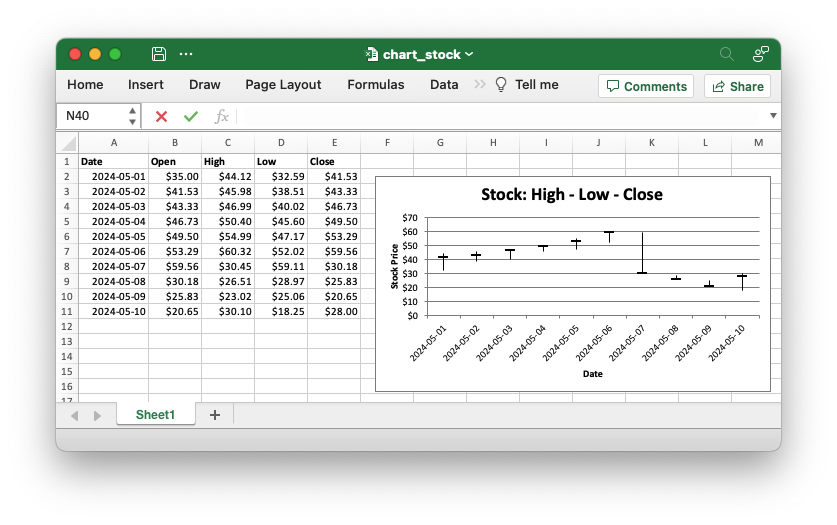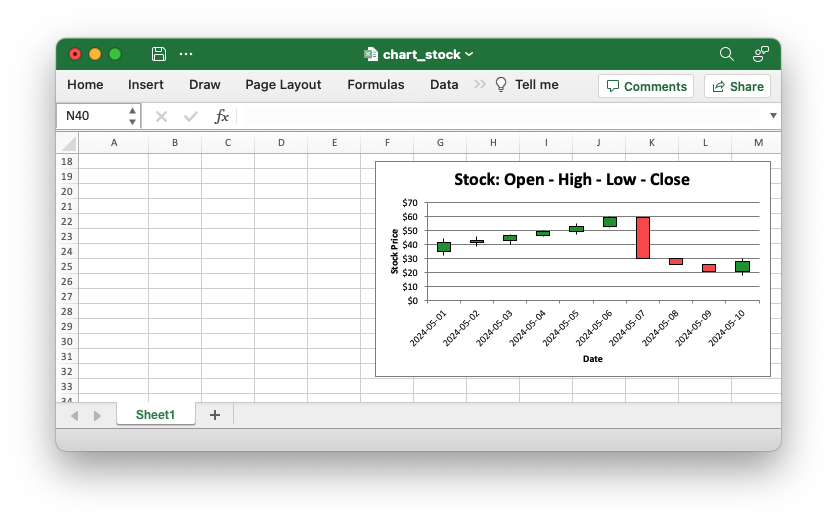Chart: Stock: Excel Stock chart example
Example of creating Excel Stock charts.
Note, Volume variants of the Excel stock charts aren't currently supported but will be in a future release.
Image of the output file:
Chart 1 in the following example is an example of a High-Low-Close Stock chart.
To create a chart similar to a default Excel High-Low-Close Stock chart you need to do the following steps:
- Create a
Stocktype chart. - Add 3 series for High, Low and Close, in that order.
- Hide the default lines in all 3 series.
- Hide the default markers for the High and Low series.
- Set a dash marker for the Close series.
- Turn on the chart High-Low bars.
- Format any other chart or axis property you need.

Chart 2 in the following example is an example of an Open-High-Low-Close Stock chart.
To create a chart similar to a default Excel Open-High-Low-Close Stock chart you need to do the following steps:
- Create a
Stocktype chart. - Add 4 series for Open, High, Low and Close, in that order.
- Hide the default lines in all 4 series.
- Turn on the chart High-Low bars.
- Turn on the chart Up-Down bars.
- Format any other chart or axis property you need.

Code to generate the output file:
// SPDX-License-Identifier: MIT OR Apache-2.0
//
// Copyright 2022-2025, John McNamara, jmcnamara@cpan.org
//! An example of creating Stock charts using the `rust_xlsxwriter` library.
//!
//! Note, Volume variants of the Excel stock charts aren't currently supported
//! but will be in a future release.
use rust_xlsxwriter::{
Chart, ChartFormat, ChartLine, ChartMarker, ChartMarkerType, ChartSolidFill, ChartType,
ExcelDateTime, Format, Workbook, XlsxError,
};
fn main() -> Result<(), XlsxError> {
let mut workbook = Workbook::new();
let worksheet = workbook.add_worksheet();
// Create some formatting to use for the worksheet data.
let bold = Format::new().set_bold();
let date_format = Format::new().set_num_format("yyyy-mm-dd");
let money_format = Format::new().set_num_format("[$$-en-US]#,##0.00");
// -----------------------------------------------------------------------
// Create some simulated stock data for the chart.
//
let dates = [
"2024-05-01",
"2024-05-02",
"2024-05-03",
"2024-05-04",
"2024-05-05",
"2024-05-06",
"2024-05-07",
"2024-05-08",
"2024-05-09",
"2024-05-10",
];
// Map the string dates to ExcelDateTime objects, while capturing any
// potential conversion errors.
let dates: Result<Vec<ExcelDateTime>, XlsxError> = dates
.into_iter()
.map(ExcelDateTime::parse_from_str)
.collect();
let dates = dates?;
let open_data = [
35.00, 41.53, 43.33, 46.73, 49.50, 53.29, 59.56, 30.18, 25.83, 20.65,
];
let high_data = [
44.12, 45.98, 46.99, 50.40, 54.99, 60.32, 30.45, 26.51, 23.02, 30.10,
];
let low_low = [
32.59, 38.51, 40.02, 45.60, 47.17, 52.02, 59.11, 28.97, 25.06, 18.25,
];
let close_data = [
41.53, 43.33, 46.73, 49.50, 53.29, 59.56, 30.18, 25.83, 20.65, 28.00,
];
// -----------------------------------------------------------------------
// Define variables so that the chart can change dynamically with the data.
//
let header_row = 0;
let start_row = header_row + 1;
let end_row = start_row + (dates.len() as u32) - 1;
let date_col = 0;
let open_col = date_col + 1;
let high_col = date_col + 2;
let low_col = date_col + 3;
let close_col = date_col + 4;
// -----------------------------------------------------------------------
// Write the data to the worksheet, with formatting.
//
worksheet.write_with_format(header_row, date_col, "Date", &bold)?;
worksheet.write_with_format(header_row, open_col, "Open", &bold)?;
worksheet.write_with_format(header_row, high_col, "High", &bold)?;
worksheet.write_with_format(header_row, low_col, "Low", &bold)?;
worksheet.write_with_format(header_row, close_col, "Close", &bold)?;
worksheet.write_column_with_format(start_row, date_col, dates, &date_format)?;
worksheet.write_column_with_format(start_row, open_col, open_data, &money_format)?;
worksheet.write_column_with_format(start_row, high_col, high_data, &money_format)?;
worksheet.write_column_with_format(start_row, low_col, low_low, &money_format)?;
worksheet.write_column_with_format(start_row, close_col, close_data, &money_format)?;
// Change the width of the date column, for clarity.
worksheet.set_column_width(date_col, 11)?;
// -----------------------------------------------------------------------
// Create a new High-Low-Close Stock chart.
//
// To create a chart similar to a default Excel High-Low-Close Stock chart
// you need to do the following steps:
//
// 1. Create a `Stock` type chart.
// 2. Add 3 series for High, Low and Close, in that order.
// 3. Hide the default lines in all 3 series.
// 4. Hide the default markers for the High and Low series.
// 5. Set a dash marker for the Close series.
// 6. Turn on the chart High-Low bars.
// 7. Format any other chart or axis property you need.
//
let mut chart = Chart::new(ChartType::Stock);
// Add the High series.
chart
.add_series()
.set_categories(("Sheet1", start_row, date_col, end_row, date_col))
.set_values(("Sheet1", start_row, high_col, end_row, high_col))
.set_format(ChartLine::new().set_hidden(true))
.set_marker(ChartMarker::new().set_none());
// Add the Low series.
chart
.add_series()
.set_categories(("Sheet1", start_row, date_col, end_row, date_col))
.set_values(("Sheet1", start_row, low_col, end_row, low_col))
.set_format(ChartLine::new().set_hidden(true))
.set_marker(ChartMarker::new().set_none());
// Add the Close series.
chart
.add_series()
.set_categories(("Sheet1", start_row, date_col, end_row, date_col))
.set_values(("Sheet1", start_row, close_col, end_row, close_col))
.set_format(ChartLine::new().set_hidden(true))
.set_marker(
ChartMarker::new()
.set_type(ChartMarkerType::LongDash)
.set_size(10)
.set_format(
ChartFormat::new()
.set_border(ChartLine::new().set_color("#000000"))
.set_solid_fill(ChartSolidFill::new().set_color("#000000")),
),
);
// Set the High-Low lines.
chart.set_high_low_lines(true);
// Add a chart title and some axis labels.
chart.title().set_name("Stock: High - Low - Close");
chart.x_axis().set_name("Date");
chart.y_axis().set_name("Stock Price");
// Format the price axis number format.
chart.y_axis().set_num_format("[$$-en-US]#,##0");
// Turn off the chart legend.
chart.legend().set_hidden();
// Insert the chart into the worksheet.
worksheet.insert_chart_with_offset(start_row, close_col + 1, &chart, 20, 10)?;
// -----------------------------------------------------------------------
// Create a new Open-High-Low-Close Stock chart.
//
// To create a chart similar to a default Excel Open-High-Low-Close Stock
// chart you need to do the following steps:
//
// 1. Create a `Stock` type chart.
// 2. Add 4 series for Open, High, Low and Close, in that order.
// 3. Hide the default lines in all 4 series.
// 4. Turn on the chart High-Low bars.
// 5. Turn on the chart Up-Down bars.
// 6. Format any other chart or axis property you need.
//
let mut chart = Chart::new(ChartType::Stock);
// Add the Open series.
chart
.add_series()
.set_categories(("Sheet1", start_row, date_col, end_row, date_col))
.set_values(("Sheet1", start_row, open_col, end_row, open_col))
.set_format(ChartLine::new().set_hidden(true))
.set_marker(ChartMarker::new().set_none());
// Add the High series.
chart
.add_series()
.set_categories(("Sheet1", start_row, date_col, end_row, date_col))
.set_values(("Sheet1", start_row, high_col, end_row, high_col))
.set_format(ChartLine::new().set_hidden(true))
.set_marker(ChartMarker::new().set_none());
// Add the Low series.
chart
.add_series()
.set_categories(("Sheet1", start_row, date_col, end_row, date_col))
.set_values(("Sheet1", start_row, low_col, end_row, low_col))
.set_format(ChartLine::new().set_hidden(true))
.set_marker(ChartMarker::new().set_none());
// Add the Close series.
chart
.add_series()
.set_categories(("Sheet1", start_row, date_col, end_row, date_col))
.set_values(("Sheet1", start_row, close_col, end_row, close_col))
.set_format(ChartLine::new().set_hidden(true))
.set_marker(ChartMarker::new().set_none());
// Set the High-Low lines.
chart.set_high_low_lines(true);
// Turn on and format the Up-Down bars.
chart.set_up_down_bars(true);
chart.set_up_bar_format(ChartSolidFill::new().set_color("#009933"));
chart.set_down_bar_format(ChartSolidFill::new().set_color("#FF5050"));
// Add a chart title and some axis labels.
chart.title().set_name("Stock: Open - High - Low - Close");
chart.x_axis().set_name("Date");
chart.y_axis().set_name("Stock Price");
// Format the price axis number format.
chart.y_axis().set_num_format("[$$-en-US]#,##0");
// Turn off the chart legend.
chart.legend().set_hidden();
// Insert the chart into the worksheet.
worksheet.insert_chart_with_offset(start_row + 16, close_col + 1, &chart, 20, 10)?;
// -----------------------------------------------------------------------
// Save and close the file.
// -----------------------------------------------------------------------
workbook.save("chart_stock.xlsx")?;
Ok(())
}